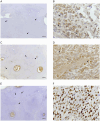Ferritinophagy: a possible new iron-related metabolic target in canine osteoblastic osteosarcoma
- PMID: 40196812
- PMCID: PMC11973301
- DOI: 10.3389/fvets.2025.1546872
Ferritinophagy: a possible new iron-related metabolic target in canine osteoblastic osteosarcoma
Abstract
Canine osteosarcomas (COS) are the most common bone tumors in dogs, characterized by high metastatic rates, poor prognosis, and poor responsiveness to routine therapies, which highlights the need for new treatment targets. In this context, the metabolism of neoplastic cells represents an increasingly studied element, as cancer cells depend on particular metabolic pathways that are also elements of vulnerability. Among these, tumor cells (TCs) show higher iron requirements to sustain proliferation (so-called iron addiction), which are achieved by increasing iron uptake and/or by activating ferritinophagy, a process mediated by the Nuclear receptor Co-Activator 4 (NCOA4) leading to iron mobilization from ferritin (Ft) deposits. Previous studies have shown that COS cells overexpress Transferrin Receptor 1 (TfR1) to increase iron uptake. In this study we evaluated the immunohistochemical expression of ferritinophagy-related proteins, namely Ferritin Heavy chain (FTH1) and NCOA4, and proliferating cell nuclear antigen (PCNA) in canine normal bone and canine osteoblastic osteosarcoma (COOS) samples. Normal samples revealed negative/weak immunoreactivity for FTH1, NCOA4 and PCNA in <10% of osteocytes. In COOS samples the majority of neoplastic cells showed immunoreactivity to FTH1, NCOA4 and PCNA. Our data suggest that the activation of ferritinophagy by COOS cells responds to the need for feed their "iron addiction." These data, though preliminary, further suggest that targeting iron metabolism represents a new potential strategy worthy of further study to be transferred into clinical practice.
Keywords: bone cancer; canine osteosarcoma; immunohistochemistry; iron metabolism; therapy.
Copyright © 2025 Power, Leandri, Federico, De Vico and Leonardi.
Conflict of interest statement
The authors declare that the research was conducted in the absence of any commercial or financial relationships that could be construed as a potential conflict of interest.
Figures


Similar articles
-
Preliminary Evidence of the Possible Roles of the Ferritinophagy-Iron Uptake Axis in Canine Testicular Cancer.Animals (Basel). 2024 Sep 9;14(17):2619. doi: 10.3390/ani14172619. Animals (Basel). 2024. PMID: 39272404 Free PMC article.
-
Expression of transferrin receptor-1 (TFR-1) in canine osteosarcomas.Vet Med Sci. 2020 Aug;6(3):272-276. doi: 10.1002/vms3.258. Epub 2020 Apr 2. Vet Med Sci. 2020. PMID: 32239803 Free PMC article.
-
NCOA4-Mediated Ferritinophagy Is a Pancreatic Cancer Dependency via Maintenance of Iron Bioavailability for Iron-Sulfur Cluster Proteins.Cancer Discov. 2022 Sep 2;12(9):2180-2197. doi: 10.1158/2159-8290.CD-22-0043. Cancer Discov. 2022. PMID: 35771492 Free PMC article.
-
The Role of NCOA4-Mediated Ferritinophagy in Health and Disease.Pharmaceuticals (Basel). 2018 Oct 23;11(4):114. doi: 10.3390/ph11040114. Pharmaceuticals (Basel). 2018. PMID: 30360520 Free PMC article. Review.
-
The Role of NCOA4-Mediated Ferritinophagy in Ferroptosis.Adv Exp Med Biol. 2021;1301:41-57. doi: 10.1007/978-3-030-62026-4_4. Adv Exp Med Biol. 2021. PMID: 34370287 Review.
References
LinkOut - more resources
Full Text Sources
Miscellaneous

